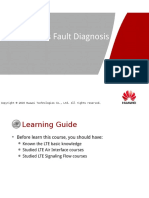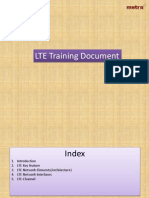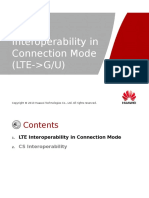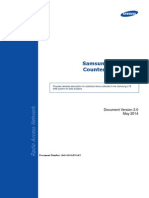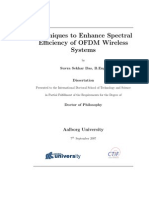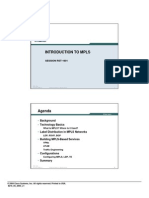Huawei LTE
Huawei LTE
Uploaded by
Amine BouazCopyright:
Available Formats
Huawei LTE
Huawei LTE
Uploaded by
Amine BouazOriginal Description:
Original Title
Copyright
Available Formats
Share this document
Did you find this document useful?
Is this content inappropriate?
Copyright:
Available Formats
Huawei LTE
Huawei LTE
Uploaded by
Amine BouazCopyright:
Available Formats
LTE PTT Broadband Trunking Solution
White Paper
Huawei Technologies CO., LTD.
All Rights Reserved
LTE PTT Broadband Trunking Solution White Paper
INTERNAL
Contents
1 Trunking Communications and Development Trend ........................................................... 3
1.1 Introduction to the TRS ................................................................................................................................................ 3
1.1.1 Challenges to and Development Trend of the TRS .................................................................................................... 4
1.1.2 Existing Trunking Systems ........................................................................................................................................ 6
2 Huawei LTE PTT Broadband Trunking Solution .................................................................. 7
2.1 Network Architecture .................................................................................................................................................... 7
2.2 Excellent System Performance ..................................................................................................................................... 9
2.2.1 Performance Counters................................................................................................................................................ 9
2.2.2 Capacity Counters .................................................................................................................................................... 10
2.3 Advanced Hardware Platform ..................................................................................................................................... 10
2.4 Advanced Video Intercom........................................................................................................................................... 13
2.5 Service Functions........................................................................................................................................................ 14
2.6 Trunking VPN ............................................................................................................................................................. 15
2.7 Powerful Dispatch console ......................................................................................................................................... 17
2.8 Open API .................................................................................................................................................................... 18
2.9 Terminal Application Interface ................................................................................................................................... 19
2.10 Various Terminals ..................................................................................................................................................... 20
2.11 Deployment Scheme ................................................................................................................................................. 22
3 Solution Development ............................................................................................................... 23
3.1 Interworking with the Existing Trunking Systems ..................................................................................................... 23
3.2 E2E Encryption ........................................................................................................................................................... 24
4 Application Case ......................................................................................................................... 25
5 Conclusion and Prospect ........................................................................................................... 27
2016-01-15
Huawei confidential. No spreading without permission.
Page 2 of 27
LTE PTT Broadband Trunking Solution White Paper
INTERNAL
Trunking Communications and
Development Trend
1.1 Introduction to the TRS
The Trunked Radio System (TRS) was first developed at the end of 1960s and the beginning
of 1970s. The basic service feature of the TRS is push to talk (PTT). Service experience of the
PTT is similar to that of interphones. Unlike common point-to-point (PTP) and full-duplex
mobile communications, the PTT uses the half-duplex and point-to-multi-point (P2MP)
communication mode. The calling party can initiate a call to one people or a group of people
by pressing a key, and the call can be immediately set up. Trunking communication services
include private calls (namely, single calls or individual calls), group calls, and broadcast calls.
The most popular group call of trunking communications is the half-duplex voice call held by
multiple persons.
The network of the TRS covers the large area or medium area. The TRS consists of the
dispatch console, switching control center, base station, and mobile station. In most cases, the
TRS provides multiple call functions, such as group calls, emergency calls, and initiating calls
to or receiving calls from the public network. In addition, the TRS can provide users with
functions, such as reliable communication channels, fast call setup, priority classification, and
dynamic regrouping.
Trunking communications provides high network reliability, high network capacity, short call
setup time (less than 500 ms), and high network security, and supports large group and large
area calls.
The TRS has the advantages, such as easy-to-use and fast call setup. The system is widely
used in many dedicated dispatching communication fields, such as railway transportation,
shipping communications, port navigation, aviation services, weather forecast, forests, mining
work, public security, electric power, petroleum, and disaster assistance. Enterprises and
government organizations can construct a common trunking network based on onsite
requirements. In the TRS, corresponding call groups, such as the government administration
group, public facility management group, environment and health group, police and security
guard group, fire fighting group, and vehicle dispatching group, can be set for different
industries, enterprises, or departments based on service requirements. With the development
of mobile communications, the application of the TRS has been widely accepted by the public.
Many countries also issue operation licenses to TRS carriers and use the TRS as a public
trunking network. The trunking network provides public services in addition to the services
for carriers. In addition, some public network carriers enable PTT services in their public
mobile networks for public users or lend PTT services to enterprises or organizations as a
trunking virtual private network (VPN).
2016-01-15
Huawei confidential. No spreading without permission.
Page 3 of 27
LTE PTT Broadband Trunking Solution White Paper
INTERNAL
1.1.1 Challenges to and Development Trend of the TRS
Similar to the public mobile communications network, the trunking communications network
is also developed from the analog technology to the digital technology and from only having
voice services to having voice and data services. The 1G trunking communications network is
an analog system that uses FDMA and provides only voice services. The 2G trunking
communications network is a digital system that uses TDMA and provides only limited data
rates (lower than 50 kbit/s) in addition to voice services. The 2G trunking communications
network can also provide some basic data services, such as the data query and small-sized file
and image transmission, but cannot provide services, such as video intercom and video
surveillance.
With the service development of trunking users and improvement of the communications
technologies, trunking users are showing an increasing demand for new services such as the
video, multimedia, and high-speed mobile broadband. However, the first- and
second-generation trunking communications networks cannot meet requirements due to
technology limitations. The 3G public mobile communications system can provide the mobile
data rates of 2 Mbit/s in the downlink and 384 kbit/s in the uplink. Although the 3G-based
digital trunking system can provide certain video and multimedia capabilities and has
achieved some success, providing PTT, mobile broadband, and video services anytime and
anywhere still cannot be achieved due to limited data bandwidths.
The MIMO- and OFDM-based LTE mobile communications technology provides high
spectral efficiency and supports the peak rate of 150 Mbit/s in the downlink and the peak rate
of 50 Mbit/s in the uplink. This brings real innovation for mobile broadband. MIMO is short
for multiple-input multiple-output. OFDM is short for orthogonal frequency division
multiplexing. The large-scale deployment and mature application of the LTE network
provides a basis for the combination of mobile broadband and professional trunking
communications and the implementation of broadband trunking communications.
2016-01-15
Huawei confidential. No spreading without permission.
Page 4 of 27
LTE PTT Broadband Trunking Solution White Paper
INTERNAL
With the rapid development of the mobile Internet and the wide application of data services,
broadband has become the development trend of all radio communications systems.
According to the conclusion in TWC 2012, TErrestrial Trunked RAdio (TETRA) and critical
communication need to be combined with the LTE in the future. Therefore, the evolution to
the LTE becomes the development trend of the TRS.
4G MBB
trunking system
4G mobile broadband
3G digital
trunking system
2G digital trunking
system
All IP and flat architecture
Excellent performance
Rich and integrated
3G and digital
service on one platform
All IP platform
Open platform
Circuit switched
High voice quality
High voice quality
Multiple channels
Data services
Rich media services (PTV)
Multiple channels
Digital technique
Picture and low bit rate
High security and privacy
FDMA
TDMA
video
Analog trunking
system
Circuit switched
Specialized department
TruStar
LiTRA
TETRA
MPT - 1327
The PTT can be used as a distinctive service for the public mobile communications network.
It brings the following benefits:
Meet the requirements of fashion people on multi-party chat and communications.
Improve the average revenue per user (ARPU) and reduce the off-net customer ratio.
Help carriers develop the enterprise and government users.
Maximize the use of investment in live networks and increase revenue.
Among public network carriers, Nextel in the United States is the most successful one that
implements the PTT services. Nextel began to use the iDEN technology since 1995 to enable
the large-scale commercial use of PTT services. This helps combine the digital cellular and
2016-01-15
Huawei confidential. No spreading without permission.
Page 5 of 27
LTE PTT Broadband Trunking Solution White Paper
INTERNAL
intercom with the text and digit. The successful operation of the PTT services provides better
performance in the increase of the user number and the ARPU value, and in user loyalty.
In a public mobile communications market that is stepping into the 4G era, the PTT services
will be one of the most important services that can attract users. PTT services can also help
carriers explore high profit markets.
1.1.2 Existing Trunking Systems
TETRA
TETRA is defined by the European Telecommunications Standards Institute (ETSI).
TETRA is the second-generation TRS. It is also a narrowband digital trunking system
that rose in 1990s. TETRA uses the TDMA mode and the carrier bandwidth of 25 kHz.
Each carrier has four timeslots. Multiple carriers are used for frequency reuse to avoid
interference. The reuse coefficient is 7 or higher. TETRA supports both voice and
low-speed data (7.2 kbit/s per timeslot and no more than 28.8 kbit/s) communications,
and only data services, such as simple data query.
TruStar
TruStar (Trunking Star) is the new-generation digital trunking solution that is developed
by Huawei based on the third-generation mobile communications technology
CDMA2000. In addition to the CS domain and PS domain inherited from the
CDMA2000 network, the TruStar system has a trunking domain. The trunking domain
enables the TruStar system to provide services, such as voice services, short message
services (SMSs), high-speed data services, trunking communications, and professional
dispatching. The three domains share the RAN resources, thereby reducing investment.
TruStar uses the CDMA technology to implement trunking communications. Trunking
communications improve the spectrum utilization, support more users, and provide voice
services and data services with the date rate of 1 Mbit/s, thereby supporting certain
multimedia services.
QChat
QChat is a PTT communications technology that is developed by Qualcomm based on
the CDMA 1xEVDO network. It belongs to the public network trunking solution. QChat
uses the binary QChat Signaling Protocol (QSP) to control the call connection. The call
setup delay can be shortened to less than 1s. QChat supports the following service
functions: single calls, group calls, temporary group call setup, chat rooms, and status
presentation. Group calls are implemented in unicast mode. QChat is deployed on the
Evolution-Data Optimized (EV-DO) network for promoting the 3G value-added services
(VASs).
2016-01-15
Huawei confidential. No spreading without permission.
Page 6 of 27
LTE PTT Broadband Trunking Solution White Paper
INTERNAL
Huawei LTE PTT Broadband Trunking
Solution
In compliance with the development trend of the digital TRS, Huawei develops the
LTE-based broadband TRS. The LTE PTT solution provides trunking services on LTE
networks by adding a PTT server and related terminals to carriers' existing networks based on
the standard LTE network.
The solution has the following key features:
High performance
Broadband and video
Open standard
Open API and rich applications
VPN (public enterprise network) and low network construction and maintenance costs
Professional trunking service quality assurance (priority and resource reservation)
Thanks to the flattened architecture of the LTE network and broadband-based air interface
design, the call setup time and E2E delay are greatly reduced. Like traditional trunking,
Huawei LTE PTT can provide better performance experience. Based on the standard evolved
multimedia broadcast/multicast service (eMBMS) feature of the LTE, LTE PTT can provide
large group calls with unlimited number of users.
Huawei draws lessons from and inherits 2G/3G trunking R&D experience and achievements
during the R&D, and provides comprehensive traditional trunking service functions in LTE
PTT.
Based on the high spectrum efficiency and bandwidth of the LTE network, LTE PTT can
provide PTT video intercom, mobile video surveillance, large file transfer, remote assistance,
and mobile dispatch consoles.
2.1 Network Architecture
Huawei LTE PTT broadband trunking solution complies with the PTT standards proposed by
3GPP and Open Mobile Alliance (OMA). The solution uses the all-IP architecture and uses
the Session Initiation Protocol (SIP) and Real-Time Transport Protocol (RTP) as the major
signaling protocols. In addition, it provides PTT services on the LTE network based on the
open and extensible network architecture.
2016-01-15
Huawei confidential. No spreading without permission.
Page 7 of 27
LTE PTT Broadband Trunking Solution White Paper
INTERNAL
By adding PTT servers and terminals supporting PTT services to the standard LTE network,
the LTE PTT solution can provide trunking services. The LTE PTT solution can provide more
optional trunking services by adding other applications to the basic network. For example, the
dispatch console provides trunking dispatch console services and the LBS Server provides
positioning services.
Figure 2-1 Logical Network Architecture of LTE PTT solution
Huawei LTE PTT broadband trunking solutions network architecture is shown as follows.
Figure 2-2 Network Architecture of Huawei LTE PTT broadband trunking solution
2016-01-15
Huawei confidential. No spreading without permission.
Page 8 of 27
LTE PTT Broadband Trunking Solution White Paper
INTERNAL
Network element description:
PTT Server
It is responsible for user authentication, forwarding, and user/group status management.
Management Client
It is responsible for trunking user creation & deletion, group creation & deletion, and
group attribute modification.
Dispatch console
An enterprise has one dispatcher, who uses a dispatch console to perform user or group
dispatch, including group members and group status query, call participation, and temporary
dispatch.
APP
It provides functions of PTT on an APP client. Users can query member status or group
list. They also can initiate private calls, group calls, and video calls on the APP client.
U2000
U2000 is a unified element management system which is responsible for O&M of PTT
servers. The O&M functions include log management, alarm management, tracing,
configuration management, real-time monitoring, and installation.
Web LMT
It is a local maintenance terminal. It provides functions including alarm management,
tracing, real-time monitoring, and configuration maintenance.
Other NEs are standard NEs in LTE systems, which are not described here.
2.2 Excellent System Performance
2.2.1 Performance Counters
Table 2-1 Performance counters of the LTE PTT system
2016-01-15
Delay
End-to-end PTT
Access Time (KPI2)
(s)
PTT Access Time
(KPI1) (s)
End-to-end
Latency
(KPI3) (s)
PTT (single call)
< 0.8 (accounting for
95% of the calls)
< 0.2 (accounting for
95% of the calls)
< 0.4
PTT (group call)
< 0.8 (accounting for
95% of the calls)
< 0.2 (accounting for
95% of the calls)
< 0.4
PTV (video
intercom)
< 0.8 (accounting for
95% of the calls)
< 0.2 (accounting for
95% of the calls)
< 0.5
Huawei confidential. No spreading without permission.
Page 9 of 27
LTE PTT Broadband Trunking Solution White Paper
INTERNAL
When only voice services are used, the PTT single call and group call setup time reaches 800
ms, PTT is achieved, the floor application time reaches 200 ms during a call, and the delay
can hardly be sensed. In addition, the E2E voice delay also can be lower than 400 ms.
When video intercom is used, a call can be set up within 800 ms and the E2E delay can be
lower than 500 ms.
The performance of the LTE PTT broadband trunking system is as good as the traditional
trunking system and meets the strict requirements of professional users.
2.2.2 Capacity Counters
Table 2-2 lists counters related to the capacity supported by the PTT server.
Table 2-2 Capacity counters
Item
Specifications
Number of registered Trunking users
100,000
Number of concurrent online Trunking users
80,000
Number of registered Trunking user groups
10,000
Number of users in a Trunking user group (unicast)
300 per group
Number of users in a Trunking user group (multicast)
1000 per group
The PTT server uses the extensible Fusion Engine platform and extensible software
architecture of Huawei to improve the system capacity based on the service development and
customer requirements in the future.
2.3 Advanced Hardware Platform
In the LTE PTT solution, the PTT server uses the Huawei FusionEngine hardware platform
that features high availability, openness, convergence, high reliability, and high performance.
FusionEngine is a carrier-class universal and COTS hardware platform that offers excellent
service and media processing capabilities, including 4 Series Chassis, as FE8001 (1U)/
FE8002 (3U)/ FE8010 (14U)/FE8016 (21U) as shown in Figure 2-1.
FusionEngine has the following features:
Compatibility
Compatible with mainstream industry software and middleware platform
FusionSphere, VMWare, KVM, RHEV etc
2016-01-15
Standardization
Universal x86/ARM computing,
General purpose storage using HDD or SSD
Popular network and I/O interfaces
IT-ization
Huawei confidential. No spreading without permission.
Page 10 of 27
LTE PTT Broadband Trunking Solution White Paper
INTERNAL
Follows Moore's Law so that keeping sync fast-paced IT industry High extensibility
Convergence
Infrastructure convergence
Multi-service convergence
Convergence of CT, IT and IP technologies
Easy to deploy
Support 800mm/1000mm depth of cabinet servers
Support ETSI wide temperature range (long-term 0~45 ),
Support CO/DC deployment standard
High Bandwidth and Access Capabilities to Remove Bottlenecks of Data Plane Loads
FusionEngine adopts a high-speed serial connection and switching structure.
FusionEngine provides an access bandwidth of 40 Gbit/s, which is scalable to 100
Gbit/s to 200 Gbit/s.
Figure 2-3 Front view of an FusionEngine-based server in full configuration mode
Currently LTE PTT solution uses FE8002(3U) as shown in Figure 2-4, Figure 2-5 & Figure
2-6. The related specification is shown in Table 2-3.
2016-01-15
Huawei confidential. No spreading without permission.
Page 11 of 27
LTE PTT Broadband Trunking Solution White Paper
INTERNAL
Figure 2-4 FusionEngine 8002 Chassis
Figure 2-5 Front View
Figure 2-6 Rear View
Table 2-3 FE8002 Specification
2016-01-15
Item
Specifications
Dimensions (H x W x D)
130.5mm 442mm 675mm
Weight
47.8 kg (full configuration)
Voltage
240 V DC; 200V AC240V AC
Huawei confidential. No spreading without permission.
Page 12 of 27
LTE PTT Broadband Trunking Solution White Paper
Item
Specifications
Power consumption
2400 W (DC) 2000W(AC)
INTERNAL
2.4 Advanced Video Intercom
Based on the high-speed data capability of the LTE network and the efficient video
transcoding capability of the Huawei Media Engine (HME), the LTE PTT solution can
provide the low delay of less than 400 ms, high resolution (supporting multiple resolutions),
and smooth video intercom experience. The solution can also provide video intercom only for
high-priority users based on the system load and bandwidth, greatly improving the
multimedia capability and user experience of trunking communications.
The HME is a multi-platform audio and video engine. The video engine component of the
HME supports various resolutions in H.264 format and functions, such as collection, display,
transcoding, network transmission, and encryption. In addition, the video engine features high
quality and low overhead, and supports software and hardware coding.
The video engine can provide high-definition (HD) images based on the intelligent image
recognition capability and intelligent compression algorithm.
The video engine reaches the low delay using the non-delay video pre-analysis algorithm,
low-delay code rate allocation algorithm, slice-level transcoding technology, and dynamic
jitter buffer technology.
The video engine has three key network adaptive technologies: network detection, dynamic
redundancy, and automatic rate selection.
In addition, the video engine can reduce the code rate to save the bandwidth when the image
becomes static. The video engine can also monitor the CPU usage. If the CPU processing
capability is insufficient, values of the communication parameters can be automatically
reduced.
2016-01-15
Huawei confidential. No spreading without permission.
Page 13 of 27
LTE PTT Broadband Trunking Solution White Paper
INTERNAL
Through the preceding technologies, the HME can encode and decode 720P@15fps video
streams when the bandwidth is 1 Mbit/s.
The HME can support the Intelligent Optimization System (IOS) platform, but applications on the LTE
PTT client do not support the IOS platform.
Based on the video intercom, the LTE PTT can provide video and image transmission
between a UE and the dispatch console. The dispatch console can use the UE as a mobile
surveillance camera to implement random and flexible monitoring and information obtaining
at any time.
2.5 Service Functions
The LTE PTT broadband trunking solution is designed and developed by taking professional
trunking functions widely used in the second- and third-generation trunking systems into full
consideration. These functions are proposed and optimized in the actual application. They
comply with user habits and improve the work efficiency in many scenarios, and therefore
they are irreplaceable.
The LTE PTT broadband trunking system integrates traditional professional trunking
functions and new features, such as the video intercom based on high-speed mobile
broadband, large file transfer, and group sharing. It provides new services for customers and
better user experience.
2016-01-15
Huawei confidential. No spreading without permission.
Page 14 of 27
LTE PTT Broadband Trunking Solution White Paper
INTERNAL
Rich trunking functions
Basic functions
Single call (PTP)
Group call
Temporary group call
Broadcast call
Late entry
Floor priority preemption
Speech duration
limitation
User, group, and
speaker number display
Supplementary
functions
Voice playback
Group member list
and status display
Group member
addition or deletion
Trunking emergency
call
Group priority
Preemptive call
Group IM
Advanced functions
Discreet Listening
File Transmission
Video Call
VPN management
Dynamic Group
Number Assignment
2.6 Trunking VPN
The investment of the TRS is huge. Co-network trunking, for example, multiple enterprises
construct and share the networks or carriers construct the networks and then enterprises lease
these networks, is the development trend and common network construction mode. For
LTE-based PTT broadband trunking, co-network trunking is also the development trend. In
public network trunking, to share network experience with enterprise customers, facilitate
enterprise self-management, and reduce the management cost of carriers, the VPN function of
the trunking network is mandatory.
The trunking VPN in the LTE PTT system can provide isolated VPNs for each enterprise and
enable some users between various VPNs to communicate with each other and inter-VPN
joint scheduling.
2016-01-15
Huawei confidential. No spreading without permission.
Page 15 of 27
LTE PTT Broadband Trunking Solution White Paper
INTERNAL
Management of the trunking VPN in the LTE PTT system is divided into two levels:
Management of the entire system: It is implemented by carriers, including user
management and enterprise trunking VPN management.
Management of the enterprise trunking VPN: It is implemented by the administrator of
the enterprise VPN.
System
Management
VPN Management
2016-01-15
Add, delete, modify, and query trunking users and the
dispatch console.
Add, delete, modify, and query enterprise information.
Add, delete, modify, and query enterprise members.
Add, delete, modify, and query enterprise groups.
Modify service configurations.
Maintain the client version.
Query and modify enterprise administrator information.
Bind enterprise-associated IP addresses.
Check enterprise statistical reports.
Chang the passwords of enterprise administrators.
Set group priorities.
Import and export group and member information.
Maintain information about lower-level administrators in a
department.
Maintain the dispatch console account.
Check report information, such as the number and usage of
registered users of an enterprise.
Huawei confidential. No spreading without permission.
Page 16 of 27
LTE PTT Broadband Trunking Solution White Paper
INTERNAL
2.7 Powerful dispatch console
The LTE PTT system contains an optional dispatch console subsystem. The trunking dispatch
console is the command and dispatching center of a trunking system. As the service center of
the trunking system, the dispatch console allows a dispatcher to:
Call trunking users and groups.
Check the status of trunking users and groups.
Implement advanced functions, such as break-in, forced release, and dynamic regrouping,
and perform management operations.
Figure 2-7 shows the functions of a dispatch console.
Figure 2-7 Functions of a dispatch console
Rich dispatching console functions
Basic functions
Single call (PTP)
Group call
Temporary group call
Highest floor priority
Dynamic regrouping
SM sending and
receiving
Group SM
Supplementary
functions
Broadcast
Break-in
Forced release
User, group, and
member information
display
Status information
display
Multi-call group
listening
Call group
combination
Group file distribution
Operation recording
Advanced functions
Remote terminal
disabling and enabling
Environment listening
Temporary user
invitation from a
dispatching console
Call authorization by a
dispatching console
Call diverting for a
dispatching console
Call recording and
replaying in a dispatching
console
Figure 2-8 shows the interface of a dispatch console.
2016-01-15
Huawei confidential. No spreading without permission.
Page 17 of 27
LTE PTT Broadband Trunking Solution White Paper
INTERNAL
Figure 2-8 Interface of a dispatch console
2.8 Open API
The LTE PTT system supports good openness and third-party development and customization,
and can integrate with the existing IT applications and Office Automation (OA) system of an
enterprise.
Openness of the LTE PTT system includes the following aspects:
The system provides an open API and allows client software developed and customized
by customers or third-parties to integrate with other systems.
The system provides client controls and a client software development tool package SDK.
SDK is short for software development kit. Third parties can develop new PTT clients
and dispatch consoles based on the SDK to implement industry-specific functions,
customized features, or other VASs, thereby meeting various demands of different
customers in different industries.
The client controls and SDK open the capabilities of the PTT system to external systems. In
this way, other systems can use the PTT system as their channels to send group SMs and
broadcast voice messages through the API, or use PTT-supported UEs as their temporary
mobile surveillance cameras.
Third-party enterprises or systems integrating with vendors can customize and develop some
features or functions in the LTE PTT trunking system. In this way, the LTE PTT trunking
system can integrate with other systems, such as the enterprise customers' application systems
or IT systems.
By using the SDK, the gateway can be developed to interconnect with other remaining analog
and digital trunking systems and enterprises' private branch exchange (PBX) telephone
systems. This helps use the existing communication facilities and achieve smooth transition.
2016-01-15
Huawei confidential. No spreading without permission.
Page 18 of 27
LTE PTT Broadband Trunking Solution White Paper
INTERNAL
2.9 Terminal Application Interface
LTE PTT terminal application software can be installed on Android-based intelligent
terminals that support LTE (the version of Android must be 4.0 or later). In this way, a
common intelligent terminal becomes a professional trunking terminal.
Figure 2-9 shows the interface for a trunking single call. In most cases, common intelligent
terminals have no dedicated PTT keys. Therefore, users need to use the virtual PTT keys on
the touchscreen to apply for the floor and answer a call. The keys in different colors indicate
the status and floor status of a call.
Figure 2-9 Interface for a trunking single call
2016-01-15
Huawei confidential. No spreading without permission.
Page 19 of 27
LTE PTT Broadband Trunking Solution White Paper
INTERNAL
Figure 2-10 shows the video intercom terminal interface and operation experience of a single
call.
Figure 2-10 Video intercom terminal interface and operation experience of a single call
2.10 Various Terminals
Users can use PTT over LTE services by downloading and installing LTE PTT client software
on an Android-based intelligent terminal that supports LTE. Customers can select desired
2016-01-15
Huawei confidential. No spreading without permission.
Page 20 of 27
LTE PTT Broadband Trunking Solution White Paper
INTERNAL
terminals from various types of terminals. Alternatively, they can use their original terminals
to save costs.
Customers can purchase various mature terminals from the markets, including:
Common mainstream smartphones
High-end light, slim, and fashionable terminals
Professional three-proofing terminals with related peripheral devices
A professional trunking terminal can provide the dedicated PTT keys, group selection button,
high-capacity battery that supports a long battery life, IP protection, and crash-proof
(MIL810C/D/E), which enable such a terminal to rival a traditional trunking terminal.
Figure 2-11 Motorola TC55 three-proofing LTE terminal (700 MHz frequency band)
2016-01-15
Huawei confidential. No spreading without permission.
Page 21 of 27
LTE PTT Broadband Trunking Solution White Paper
INTERNAL
Figure 2-12 Samsung GALAXY Active three-proofing LTE terminal
2.11 Deployment Scheme
The deployment and evolution of the LTE PTT solution in the existing LTE network can be
divided into the following two stages:
Standard LTE network + PTT server (The PTT server is embedded with the required
IMS function subset.)
PTT services are provided quickly on the existing network to attract more users.
The network is evolved by following standard protocols and can provide better QoS for
PTT services.
The LTE access network is optimized to improve the access speed, coverage, and QoS.
In addition, more eMBMS CN devices are added to provide eMBMS-based PTT group
calls with larger capacity and less interface resources.
2016-01-15
Huawei confidential. No spreading without permission.
Page 22 of 27
LTE PTT Broadband Trunking Solution White Paper
INTERNAL
Solution Development
3.1 Interworking with the Existing Trunking Systems
Enterprises and carriers have deployed a lot of digital trunking networks, such as the TETRA.
After users deploy the LTE PTT system, the original systems do not immediately exit the
network but continue to be used to protect investments. Therefore, the new LTE PTT system
will co-exist with the original trunking systems within a certain phase. The LTE PTT system's
interworking with the original trunking systems can improve the work efficiency and facilitate
user migration and smooth network swapping.
The existing trunking systems do not provide standard interconnection and interworking
interfaces. Therefore, proper interworking solutions must be customized for different systems.
The TETRA is used as an example. In most cases, the TETRA provides the dispatch console
API for secondary development, including the interface for implementing the dispatch
console's PTT call function. By using the dispatch console API, Huawei can customize and
develop the interworking gateway for the LTE PTT system and TETRA, thereby achieving
the single call interworking and hybrid group call between the LTE PTT system and TETRA.
Users or TETRA providers on the live network must provide their dispatch console APIs and
technical support for the development of the interworking gateway.
The interworking gateway feature is a customized feature. It is determined based on project
requirements and customers need to provide interfaces and technical information required for
interconnection and interworking.
2016-01-15
Huawei confidential. No spreading without permission.
Page 23 of 27
LTE PTT Broadband Trunking Solution White Paper
INTERNAL
3.2 E2E Encryption
Compared with GSM and UMTS networks, the LTE network provides a more complete
encryption and integrity protection mechanism on the air interface. The protection, however,
needs to be enhanced on the wired network. Encryption protection that is performed only on
the link layer by segment still has security risks. Industry customers that have high security
requirements have strong requirements on application-layer E2E encryption. Huawei
introduces the hardware-based E2E encryption solution to the UMTS-based TruStar trunking
system. This solution meets the security requirements of high-end customers and has good
effect in actual applications.
The hardware-based E2E encryption solution will also be introduced to the LTE PTT trunking
system based on the TruStar technology in the future.
The hardware-based E2E encryption feature is a customized feature. It is determined based on project
requirements.
Encryption Path
Air Interface
terrestrial link
eNodeB
Encryption UE
Core Network
Air Interface
eNodeB
Encryption UE
Voices, videos, and SMs are encrypted on any devices and links in the entire system, and
therefore cannot be intercepted.
2016-01-15
Huawei confidential. No spreading without permission.
Page 24 of 27
LTE PTT Broadband Trunking Solution White Paper
INTERNAL
Application Case
Huawei provides the LTE PTT solution for Vodafone in WMC 2014. In WMC, Huawei shows
the LTE PTT solution as a Vodafone LTE trunking solution and enable customers, such as the
Vodafone chief technology officer (CTO) and senior government officials, to experience the
service.
Huawei LTE PTT solution is the only one PTT solution that supports video intercom in WMC
2014. With its excellent performance, good experience, and clear and smooth video, the
solution impresses Vodafone senior officers, government customers, and other visitors to the
WMC.
Figure 4-1 Demonstration of the LTE PTT solution in WMC 2014
2016-01-15
Huawei confidential. No spreading without permission.
Page 25 of 27
LTE PTT Broadband Trunking Solution White Paper
2016-01-15
Huawei confidential. No spreading without permission.
INTERNAL
Page 26 of 27
LTE PTT Broadband Trunking Solution White Paper
INTERNAL
Conclusion and Prospect
The rapid development and wide and in-depth application of mobile broadband services,
smartphones, and the mobile Internet bring huge impacts and also great opportunities of
transformation and upgrade to traditional industries and applications including the trunking
communications industry.
After years of utilization experience and service development requirements, users in the
traditional TRSs have strong demands on the following parts:
Various communication services (for example, video services)
High-speed and ready-to-use mobile broadband services
Rich and complete data services
Various and cost-effective terminals on which software can be installed to expand
functions
Open, customizable, and extendable network and system platforms
However, the traditional TRSs can provide the date rate only of lower than 50 kbit/s due to
outdated technologies and can barely support the most basic applications, such as data query
data and text. The LTE network is mature and widely used, which provides a basis for the
fulfillment of the preceding demands. The LTE network uses the latest mobile
communications technologies. With the latest technologies, the LTE network can provide a
maximum downlink data rate of 150 Mbit/s and a maximum uplink data rate of 75 Mbit/s
with a bandwidth of 20 MHz. In addition, the LTE network has high spectral efficiency and
perfect QoS assurance mechanisms, and therefore can carry real-time services, such as voice
and video services. Therefore, it has become the latest development trend for customers to
construct a professional TRS based on the LTE network to integrate the advantages of the
TRS and LTE network and provide a new driving force for trunking communications.
To follow this trend, Huawei provides the LTE-based professional trunking communications
solution, LTE PTT. The LTE PTT solution can provide mobile broadband, group voice call,
and group video call services for a UE in a network at the same time. As an open platform and
API, the solution allows users to perform customization and application extension. In addition,
to improve the performance and capacity of the LTE PTT system, the LTE network needs to
be optimized to rival the professional trunking communications system.
As the new-generation broadband TRS, the LTE PTT system provides new energy and vitality
for trunking communications based on the LTE technology and provides better assurance for
users' service development and success.
2016-01-15
Huawei confidential. No spreading without permission.
Page 27 of 27
You might also like
- LTE RAN Parameters Ericsson HuaweiDocument115 pagesLTE RAN Parameters Ericsson HuaweiPranayPatnaikNo ratings yet
- Access Class Control (eRAN15.1 - 01) PDFDocument57 pagesAccess Class Control (eRAN15.1 - 01) PDFwaelq2003No ratings yet
- Oea000100 Lte Air Interface Issue 1.06Document248 pagesOea000100 Lte Air Interface Issue 1.06binhlethinhnhung5242No ratings yet
- Data Science and Big Data Computing - Frameworks and MethodologiesDocument332 pagesData Science and Big Data Computing - Frameworks and MethodologiesMihailo Majk Žikić90% (10)
- Huawei: H31-611 ExamDocument3 pagesHuawei: H31-611 ExamVidusheeNo ratings yet
- LTE Self-Organising Networks (SON): Network Management Automation for Operational EfficiencyFrom EverandLTE Self-Organising Networks (SON): Network Management Automation for Operational EfficiencySeppo HämäläinenNo ratings yet
- LTE Radio Network Capacity Dimensioning ISSUE 1.10Document36 pagesLTE Radio Network Capacity Dimensioning ISSUE 1.10Mita Heidyani100% (2)
- RACH Optimization (ERAN3.0 01)Document22 pagesRACH Optimization (ERAN3.0 01)Luis Terry TorresNo ratings yet
- LTE KPI IntroductionDocument95 pagesLTE KPI IntroductionemmyjoNo ratings yet
- Solution-Based VoLTE Technical Training Slide V1.0Document37 pagesSolution-Based VoLTE Technical Training Slide V1.0Ahmed GadNo ratings yet
- LTE Air InterfaceDocument60 pagesLTE Air InterfaceJoan Velasquez50% (2)
- Huawei LTE KPI OptimizationDocument61 pagesHuawei LTE KPI OptimizationMed Amine100% (1)
- Huawei Speeds Up 4G Development: April 28, 2009Document16 pagesHuawei Speeds Up 4G Development: April 28, 2009max98No ratings yet
- LTE Access Fault Diagnosis ISSUE2 00Document95 pagesLTE Access Fault Diagnosis ISSUE2 00CannaNo ratings yet
- LTE Data Transmission Analysis ManualDocument53 pagesLTE Data Transmission Analysis ManualStanislas Arthur LishuNo ratings yet
- Huawei LTE Cell PlanningDocument64 pagesHuawei LTE Cell PlanningMuhammad UsmanNo ratings yet
- The Air Interface For GSM EDGEDocument6 pagesThe Air Interface For GSM EDGEDayanidhi PandaNo ratings yet
- LTE Feature Introduction Part1Document87 pagesLTE Feature Introduction Part1Stanislas Arthur LishuNo ratings yet
- RAN Troubleshooting Guide (01) (PDF) - EN PDFDocument193 pagesRAN Troubleshooting Guide (01) (PDF) - EN PDFAhmedMa'moon0% (1)
- Huawei ERAN6.1 MIMO Adaptive SwitchDocument2 pagesHuawei ERAN6.1 MIMO Adaptive SwitchMudassir AliNo ratings yet
- Introduction To LTE Feature 2.0Document68 pagesIntroduction To LTE Feature 2.0Muhammad Iqbal Khan SonNo ratings yet
- Huawei LTE E-RAB Setup Success Rate AnalisisDocument10 pagesHuawei LTE E-RAB Setup Success Rate AnalisisOptimización RF0% (1)
- 02 LTE Air Interface and Physical LayerDocument54 pages02 LTE Air Interface and Physical LayerSoumen MohantyNo ratings yet
- Capacity Dimensioning HuaweiDocument11 pagesCapacity Dimensioning HuaweiBarbaros YabaciNo ratings yet
- VoLTE KPIDocument2 pagesVoLTE KPIMajid HussainNo ratings yet
- Lte V2Document117 pagesLte V2ajay_kangra100% (1)
- Huawei - LTE Network Tuning Issue - 2Document30 pagesHuawei - LTE Network Tuning Issue - 2Nik100% (1)
- LTE Radio Network Planning Introduction PDFDocument41 pagesLTE Radio Network Planning Introduction PDFAli OsmanNo ratings yet
- Security Level RTWP Troubleshooting UideDocument57 pagesSecurity Level RTWP Troubleshooting UideanthonyNo ratings yet
- Coverage Optimization: 秘密 Proprietary Confidential▲Document24 pagesCoverage Optimization: 秘密 Proprietary Confidential▲DativaNo ratings yet
- Xxxyyyyzzzzzz 4G Basic Training DocumentDocument25 pagesXxxyyyyzzzzzz 4G Basic Training DocumentAbhishek SinghNo ratings yet
- 3 LTE Interoperability in Connection Mode (LTE-GU)Document152 pages3 LTE Interoperability in Connection Mode (LTE-GU)Fawad Hasan67% (3)
- Lte KpiDocument19 pagesLte Kpikhalis@hotmail.comNo ratings yet
- LTE Timing Advance PDFDocument6 pagesLTE Timing Advance PDFdtvt40No ratings yet
- Dokumen - Tips Lte Basic Actions For Throughput TroubleshootingDocument16 pagesDokumen - Tips Lte Basic Actions For Throughput Troubleshootingmohsin881No ratings yet
- LTE Signaling - AttachDocument21 pagesLTE Signaling - AttachYoyok Dwi ParindraNo ratings yet
- 3G - RNO OptimizationDocument58 pages3G - RNO OptimizationCristopher TimarioNo ratings yet
- Call Fail Analysis GuidelineDocument20 pagesCall Fail Analysis GuidelineAhmadArwaniNo ratings yet
- LTE FDD eRAN11.1 LTE-A Feature Description 01 (20160426) PDFDocument43 pagesLTE FDD eRAN11.1 LTE-A Feature Description 01 (20160426) PDFAndrey prashkovichNo ratings yet
- 3G RF OptimizationDocument53 pages3G RF Optimizationmkmittal21No ratings yet
- Samsung MBS (LTE) Counter Description For SLR 3 1 - V 03 00Document419 pagesSamsung MBS (LTE) Counter Description For SLR 3 1 - V 03 00Sunil KumarNo ratings yet
- RNP Training 2024Document71 pagesRNP Training 2024nguyenky0511No ratings yet
- 2) LTE Air InterfaceDocument76 pages2) LTE Air Interfacegh_jazani100% (1)
- 4G Huawei - UL Interference CancellationDocument6 pages4G Huawei - UL Interference CancellationPutihPutihLompatLompatNo ratings yet
- OEB537110 LTE ERAN15.1 VoLTE Service Activation and Data ConfigurationDocument123 pagesOEB537110 LTE ERAN15.1 VoLTE Service Activation and Data ConfigurationHegarPradiptaSudradjatNo ratings yet
- PRACHDocument41 pagesPRACHmonem777No ratings yet
- 3 .MIMO Features & AlgoritmsDocument25 pages3 .MIMO Features & Algoritmsrahmat effendi100% (1)
- LTE Network Interference AnalysisDocument47 pagesLTE Network Interference Analysismazen ahmedNo ratings yet
- Huawei UMTS Radio Network Planning Introduction: Huawei Technologies Co., LTDDocument40 pagesHuawei UMTS Radio Network Planning Introduction: Huawei Technologies Co., LTDsmhassan159100% (1)
- Huawei LTE EPS End To End IP Protocol AnalysisDocument87 pagesHuawei LTE EPS End To End IP Protocol AnalysisMuhammad UsmanNo ratings yet
- Introduction To LTE Feature PDFDocument41 pagesIntroduction To LTE Feature PDFAngel RiveraNo ratings yet
- eNodeB KPI ReferenceDocument42 pageseNodeB KPI Referencejosine.conti5913No ratings yet
- Win GSM&UMTS Refarming With Huawei For Viettel - v1.0 (ComDocument42 pagesWin GSM&UMTS Refarming With Huawei For Viettel - v1.0 (ComNguyen Manh100% (1)
- LTE RF Optimization Training PDFDocument4 pagesLTE RF Optimization Training PDFkhalifaNo ratings yet
- DRX 160511085952Document195 pagesDRX 160511085952Sandeep KadamNo ratings yet
- Spectral Efficiency of Wireless NetworkDocument274 pagesSpectral Efficiency of Wireless NetworkkhrumNo ratings yet
- Huawei 4G - CDR PS Fast AnalyzeDocument5 pagesHuawei 4G - CDR PS Fast AnalyzePutihPutihLompatLompatNo ratings yet
- VoLTE and ViLTE: Voice and Conversational Video Services over the 4G Mobile NetworkFrom EverandVoLTE and ViLTE: Voice and Conversational Video Services over the 4G Mobile NetworkNo ratings yet
- Introduction To MPLS: Session Rst-1601Document46 pagesIntroduction To MPLS: Session Rst-1601Srikanth ThiyagarajanNo ratings yet
- IPv4 Multicast PDFDocument1 pageIPv4 Multicast PDFAmine BouazNo ratings yet
- Internet Protocol Television (Iptv) - Architecture & ChallengesDocument13 pagesInternet Protocol Television (Iptv) - Architecture & ChallengesAmine BouazNo ratings yet
- Going Faster and Staying in Control: - Building The World's Biggest NGNDocument18 pagesGoing Faster and Staying in Control: - Building The World's Biggest NGNAmine BouazNo ratings yet
- Net Implementation White Paper0900aecd806530a4Document12 pagesNet Implementation White Paper0900aecd806530a4Amine BouazNo ratings yet
- 2011-IPTV Course Notes PDFDocument60 pages2011-IPTV Course Notes PDFLink NguyenNo ratings yet
- Mimo Wifi NabarDocument33 pagesMimo Wifi NabarAmine BouazNo ratings yet
- IPTV WalkerDocument30 pagesIPTV WalkerAmine BouazNo ratings yet
- MPLS TE Technology White PaperDocument30 pagesMPLS TE Technology White PaperAmine BouazNo ratings yet
- Matlab Help TextDocument62 pagesMatlab Help TextAmine BouazNo ratings yet
- NotesDocument112 pagesNotesAyush SinghNo ratings yet
- EECE 5155 Syllabus Fall 2023Document5 pagesEECE 5155 Syllabus Fall 2023Soniya KadamNo ratings yet
- Infusion Zebos Advanced Routing Suite: June, 2003Document118 pagesInfusion Zebos Advanced Routing Suite: June, 2003anh00No ratings yet
- Lesson 1 - Empowerment NotesDocument7 pagesLesson 1 - Empowerment NotesRodelyn Ramos GonzalesNo ratings yet
- Security Concepts: Unit - I Security Concepts: Introduction, The Need For Security, Security Approaches, Principles ofDocument47 pagesSecurity Concepts: Unit - I Security Concepts: Introduction, The Need For Security, Security Approaches, Principles ofSAI CHAND 18-522No ratings yet
- Samsung TV GuideDocument145 pagesSamsung TV GuidestanicliNo ratings yet
- Faq 2016 Netriders Apac Ccent enDocument17 pagesFaq 2016 Netriders Apac Ccent enRushlan KhanNo ratings yet
- AXIS M3045-WV Network Camera: HDTV 1080p / 2 MP Fixed Mini Dome With HDMI and Wireless ConnectionDocument2 pagesAXIS M3045-WV Network Camera: HDTV 1080p / 2 MP Fixed Mini Dome With HDMI and Wireless ConnectionkoswaterNo ratings yet
- IP Address in NetworkingDocument11 pagesIP Address in NetworkingSumit PatilNo ratings yet
- Quiz 1Document7 pagesQuiz 1Markkandan ShanmugavelNo ratings yet
- InBio Pro-Installation-Guide-20160215Document32 pagesInBio Pro-Installation-Guide-20160215احمد المقرميNo ratings yet
- A Network Is A Group of Devices That Are Connected in Such A Manner That They Can Share Information and Resources With Each OtherDocument2 pagesA Network Is A Group of Devices That Are Connected in Such A Manner That They Can Share Information and Resources With Each OtherMary Anthariz MoyoNo ratings yet
- PD 401 & PD 401-A, RA 7832, and RA 10515Document6 pagesPD 401 & PD 401-A, RA 7832, and RA 10515thedoodlbotNo ratings yet
- DVR User's Manual V1.2.0Document361 pagesDVR User's Manual V1.2.0Bagi CsabaNo ratings yet
- M3-R3: Internet and Web Design: Total Time: 3 Hours Total Marks: 100Document4 pagesM3-R3: Internet and Web Design: Total Time: 3 Hours Total Marks: 100Ghanshyam SharmaNo ratings yet
- TRM Minilinktnpresentationbykhalil 170517191312 PDFDocument94 pagesTRM Minilinktnpresentationbykhalil 170517191312 PDFjamos200100% (2)
- 19CS406 CN QR-1Document13 pages19CS406 CN QR-1nandyalamalyadrireddy205No ratings yet
- FM-60 Flexible Multiplexer User's Manual: Version A2.0, February-12-2004Document257 pagesFM-60 Flexible Multiplexer User's Manual: Version A2.0, February-12-2004Saptarshi ChatterjeeNo ratings yet
- PowerFactory2017 EN Rev.2 PDFDocument16 pagesPowerFactory2017 EN Rev.2 PDFVictor Macedo AchancarayNo ratings yet
- User Manual: Ac750 Wifi RouterDocument138 pagesUser Manual: Ac750 Wifi RouterKevin KimNo ratings yet
- Trellix Endpoint Security PlatformDocument22 pagesTrellix Endpoint Security PlatformJose Alberto Ramirez RamirezNo ratings yet
- 02 - Parallel ProgrammingDocument27 pages02 - Parallel ProgrammingDd dNo ratings yet
- Thesis 12345Document20 pagesThesis 12345Jeziel MorcillaNo ratings yet
- Citation 28 - On-The-Combination-Of-Naive-Bayes-And-Decision-Trees-For-IntrusiDocument6 pagesCitation 28 - On-The-Combination-Of-Naive-Bayes-And-Decision-Trees-For-IntrusiZahedi AzamNo ratings yet
- Gprs Protocol StackDocument2 pagesGprs Protocol Stackapi-3708986No ratings yet
- 7th SEM IOT (CSE & ME)Document1 page7th SEM IOT (CSE & ME)Aswini Kumar Palo100% (1)
- Wk12 - Motivations-Protocol Design and ValidationDocument23 pagesWk12 - Motivations-Protocol Design and ValidationDahlia GamalNo ratings yet
- Waste Classifier Major ProjectDocument25 pagesWaste Classifier Major Projectkk1742003No ratings yet














